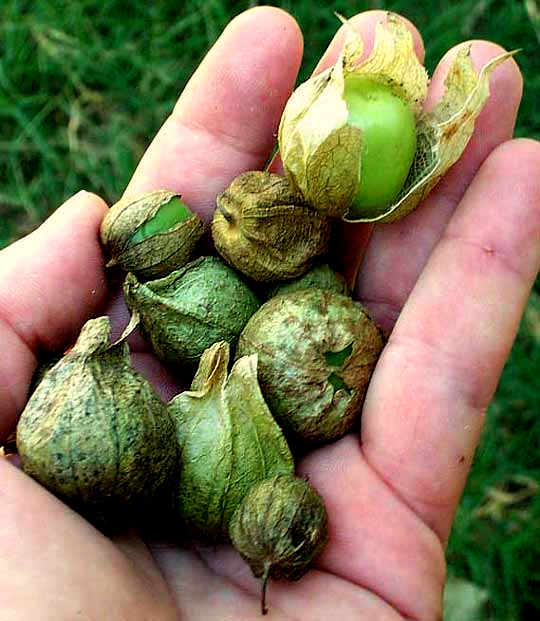Excerpts from Jim Conrad's
Naturalist Newsletter
from the May 12, 2007 Newsletter issued from Sierra Gorda Biosphere Reserve, QUERÉTARO, MÉXICO
HUSK TOMATOES/ TOMATILLOS
In restaurants here typically you have placed onto your table a little wicker basket filled with hot tortillas draped with a white, embroidered cloth, plus they also bring a small, rusty-red, ceramic bowl filled with hot- sauce. Good restaurants give you two bowls, one with green hot-sauce and the other with red.
In Mexico the green hot-sauce is based on fruit of the plant known by the Latin name of PHYSALIS IXOCARPA. In North America we often call the fruits "tomatillos" (toh-mah-TEE-yos) or "husk tomatoes." The latter name is appropriate because the fruits look like small, green tomatoes of the regular sort suspended inside a dry, papery bladder. Hanging on the plant the fruits look like Chinese lanterns. Wild Physalises produce smaller fruits suspended in bladders, and you can visualize what purpose the bladders serve. When the husked fruit falls to the ground, wind blows the bladder around like a tumbleweed, helping the seeds disperse into new territory. In the market this week I bought a handful of husk tomatoes to show you. They're shown below:

Husk tomatoes have been part of indigenous Mexican cuisine for thousands of years, and the last time I was in a US supermarket they were on sale up there, too. The ones up there were nearly the size of regular tomatoes. I think folks here would regard those as too watery and lacking much taste. You can read all about tomatillos or husk tomatoes at http://www.floridata.com/ref/p/phys_ixo.cfm.
The Spanish terms for red tomatoes and husk tomatoes -- which are in the same family but different genera -- can be confusing.
In our part of Mexico the regular, red, huskless tomato is called jitomate (hee-toe-MAH-teh), while husk tomatoes are referred to as tomates (toe-MAH-tehs). However, my Spanish-English dictionary gives only one translation for the English red "tomato," and that's tomate. In the Spanish section my dictionary does list the word jitomate as a special Latin-American Spanish term for "tomato." In fact, in some parts of Mexico they also use tomate for "tomato." So, a red, English tomato is either a jitomate or a tomate, and the husk tomato is either a tomatillo or a tomate, depending on where you are. Several times I've lost my credibility as an effective Spanish-speaker by walking into a market and using the wrong word for tomato.
Of course the words "tomato" and tomate are so similar because "tomato" was derived from the Spanish tomate, which in turn had been taken from the native-Mexican Nahuatl (language of the ancient Aztecs) tomatl -- which was based on the Nahuatl word tomana meaning "to swell." So, tomatoes are "swollen fruits." But who knows whether the Aztecs were talking about red English tomatoes or green husk-tomatoes?